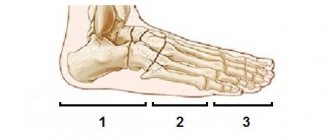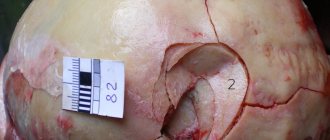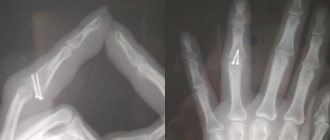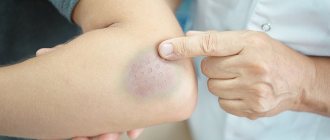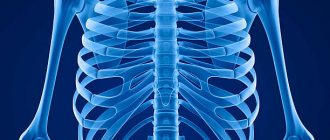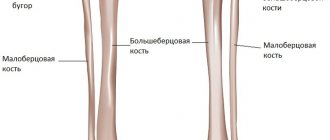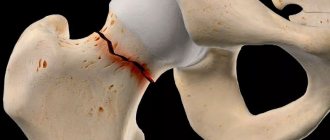First aid for a closed fracture
When providing first aid for a closed fracture, you should immediately contact an ambulance. After this, it is necessary to immobilize the broken limb and, if possible, apply ice or a cold object to the injury site. The person may be given a painkiller. When transporting independently, a splint is applied using available items: board, stick, ski, etc.
In the absence of available means, the injured limb is bandaged to the uninjured one. During transportation, the victim must lie down - the broken limb should be slightly raised.
How to treat the victim
The patient is delivered in a half-sitting, half-lying state, not being left alone for a minute. When applying a splint, the limb must be given a natural physiological position. But it is absolutely forbidden to set joints or create bone fragments on your own, as this is fraught with serious complications. Such unskilled actions can lead to damage to nerves and blood vessels, and then a routine consultation with a neurologist will no longer be able to correct the situation, which can lead to increased traumatic shock and death.
If a person has broken pelvic bones or spine, it is strictly forbidden to move him until doctors arrive. The only thing that is allowed is, with the participation of three assistants, to carefully transfer it to a hard surface, such as a door leaf, table top or board flooring. During transportation, the victim must maintain his original position.
First aid for an open fracture
Such an injury is extremely dangerous, as the wound can become infected. First aid for an open fracture begins with stopping bleeding using a pressure bandage or tourniquet if significant blood loss is observed. Antiseptic preparations are used to treat the skin around the wound. To transport the victim, it is necessary to carefully apply a splint without touching the wound.
Achilles tendon injuries.
The Achilles tendon is located at the back of the lower leg. In case of injuries to this part of the leg, a characteristic sign will be a crunching sound. The resulting injury of this kind makes it impossible to raise the heel and rise onto the toe; the lower part of the leg swells within an hour. A cold compress can relieve pain and slow down swelling. It is necessary to extend the toe of the foot, bend the leg slightly at the knee and secure the limb in this position so that both joints are motionless. It is good to bandage a solid bar, for example, a school ruler or part of a thin board, to the shin and the outer part of the foot. It is strictly not recommended to step on the injured leg, and if a rupture occurs, the patient should be taken to the hospital.
If there are open wounds on the lower leg, first aid is provided in the following order:
1. Clean the surrounding skin of dirt and, if possible, disinfect it.
2. Stop the bleeding with a homemade tourniquet or pressure bandage.
3. Apply clean gauze or a piece of cloth that you have on hand.
It is necessary to deliver a person to a medical facility quickly so that the hospital removes the tourniquet, which blocks access to the blood flow.
Types of fractures
Broken arm
First aid for arm fractures is based on prompt immobilization of the limb, application of a splint and fixation. Severe pain is relieved with painkillers. If pain shock begins to develop, the victim is warmed up and given hot tea. It should be noted that drinking is prohibited if the patient is vomiting or has an abdominal injury. When the symptoms of shock are eliminated, the injured person can be moved.
An open fracture of the arm requires stopping the bleeding using a tourniquet, which is applied above the injury. Antiseptics are used to treat the wound. Having stopped the bleeding and treated the wound, it is necessary to carry out the procedure of fixing the hand.
Attempts to realign bones are strictly prohibited.
Broken leg
First aid for leg fractures involves using a splint to secure the limb. An open injury may bleed, so stop the bleeding using a tourniquet. The wound is treated with antiseptics, and if the victim feels severe pain, anesthetics are used.
Independent attempts to straighten the bone are strictly prohibited.
Spinal fracture
A spinal fracture is a serious injury that threatens the life of the victim. For such a fracture, pain relief must be given very quickly, and the body must be fixed immediately. To move a person, boards, doors, and plywood are used. The head is fixed with a rigid collar made of suitable items.
It is prohibited to sit down, try to stand, pull the limbs, or straighten the spinal column of the victim.
Pelvic fracture
A pelvic fracture can be accompanied by severe complications and internal bleeding, which sometimes result in disability and death. When providing first aid in such cases, you should examine the victim, immobilize him in a supine position (knees should be bent), fix the pelvis, and raise the knees with a roller. In addition, the patient’s condition should be constantly monitored until doctors arrive.
It is forbidden to seat or try to position a patient.
Fractured ribs
When a rib is fractured, internal organs and the cardiovascular system can be damaged, which is very dangerous for the victim. However, a simple fracture of one or two ribs does not require the attention of specialists - the patient recovers on his own. In difficult cases, it is necessary to urgently hospitalize the injured person and provide him with qualified assistance.
This type of fracture requires rest, so it is worth limiting active movements and sports.
Tibia fracture
First aid for lower leg injuries consists of fixing the limb, applying a splint, and administering painkillers to the patient. If there is bleeding, a tourniquet is applied.
Repositioning the bone is strictly prohibited.
Shoulder fracture
A shoulder injury can be complicated by internal hemorrhage, which is extremely dangerous to health. The patient needs immobilization for a fracture using a splint, and he should also be given painkillers. The victim must be moved in a sitting position.
It is forbidden to straighten the shoulder and carry the patient without fixing the limb.
Treatment of fractures at the MedikCity clinic
If you need emergency and professional help, then contact the paid emergency room of the MedicCity clinic!
We work every day from 9.00 to 21.00. X-rays work for you in the same mode, and we perform MRIs around the clock!
Experienced traumatologists use in their work all the advanced methods of treating fractures, as well as modern, high-quality materials, in particular plastic plaster, which is lightweight, does not deform from water and is comfortable to wear.
Types of modern plastic plaster
One of the easiest is Scotchcast . The patient practically does not feel its weight, and the body breathes in it. Scotch tapes are available in various colors, which slightly “brightens up” not the easiest period in a person’s life. Among the disadvantages, it can be noted that the plaster cannot be exposed to water (it is put on with a special cotton-rag stocking, which serves as a layer between the rough material and the skin), and it can only be removed with the help of a specialist.
Softcast is a bandage made of a very flexible, elastic material, which allows it to be used for sprains and sprains. In cases of fractures, the bandage is worn together with adhesive tape. This plaster is made from fiberglass fabric impregnated with polyurethane resin and is therefore water resistant. In this case, the cast ensures the flow of air to the injured limb.
HM-cast is a synthetic mesh with large cells, made in the shape of a sleeve. It is very light, but you only need to wear it with a special synthetic stocking. This product can be used for water procedures; it is very light in weight and is available in various sizes, which makes it convenient for treating limb fractures of different locations. This cast allows X-ray penetration, allowing specialists to monitor bone healing without removing the cast.
Turbocast is the most common plastic gypsum with high strength. A cotton stocking is not worn under this cast, so you can take water procedures in the turbocast. Another plus is that this material has a working memory, so it can be heated and used repeatedly. A turbocast plaster cast looks aesthetically pleasing and is easy to use (it can be hygienically treated with a soap solution).
In our clinic you can replace the uncomfortable old plaster cast with a modern lightweight turbocast bandage. Follow our promotions! Very often there is a discount on the plaster replacement procedure.
If necessary, the doctor will quickly and professionally install an orthosis for you and remove the Ilizarov apparatus. If you need to remove an Ilizarov apparatus, you can find out the cost of the service by phone.
Possible knee injuries
The loads on the connected apparatus in the knee of athletes are very serious, so when they are exceeded, injuries occur. In this case, displacement is observed, and the shape of the joint changes due to swelling. This means that the injury is accompanied by damage to blood vessels and leakage of blood into the nearby area. The injury causes pain when trying to bend or straighten the leg at the knee. Ruptures inside simultaneously damage blood vessels and blood flows out faster. Swelling appears quickly. With ordinary bruises, the joint swells gradually.
Knee injuries that occur at home, on the sports field, require the application of a round bandage of cotton wool and gauze around the patella - it is fixed in a motionless state. Then cold should be applied. Putting pressure on your leg is strictly prohibited; you should immediately contact a medical facility and conduct a detailed diagnosis.
An unnatural position of the limb during a fall or stress can cause complete rupture of the ligaments, their cracks or sprains. A sharp pain appears, the lower leg deviates to the side, and subcutaneous hemorrhage can be observed. Joint swelling due to rupture of blood vessels appears within an hour.
The first thing to do when a ligament is torn or there is pain at its location is not to try to move the damaged area, if possible, apply ice.
People who subject themselves to physical activity sometimes experience a tear of the meniscus, the cartilage tissue located inside the knee. In this case, part of it may end up in the joint cavity and will interfere with moving the knee. It is impossible and not recommended to eliminate the consequences of such infringement on your own. The joint is fixed motionless and the person is taken to the hospital.
The displacement of the patella can be corrected on your own, after which you must apply a fixing bandage and take an x-ray in the hospital. If necessary, the surgeon will remove blood accumulated in the muscles and apply a plaster cast. If these measures are neglected, then due to weakness and poor healing of the ligaments, patellar dislocation may occur in the future.
A sprained leg is one of the most severe and painful injuries, after which surgery under general anesthesia will be required. The tibia moves back or forward, causing compression or rupture of blood vessels and nerves, which can lead to painful shock. Disruption of blood supply is dangerous because tissues do not receive oxygen and necrosis begins. Swelling and changes in the shape of the joint are typical signs of such damage. Movement of the joint becomes impossible due to a violation of the position of the bones relative to each other. Reduction requires general anesthesia and manipulation under sterile conditions. If a long trip to the hospital is necessary, and there are signs of ruptured blood vessels, then you can lightly pull the injured leg by the foot to try to move the lower leg closer to the natural position of the bones, but this must be done with extreme caution, since the procedure is extremely painful - a person with a low pain threshold may lose consciousness or experience painful shock. Transportation of an injured person is possible only if immobilized with a medical or homemade splint.
An intra-articular fracture is characterized by severe pain, changes in the shape and swelling of the joint, and internal hemorrhage. Swelling extends to the lower leg. This injury is extremely serious, as it requires the application of plaster along the lateral surface of the ribs to the very bottom of the limb, as well as along the inner side of the thigh to the foot. After this, the person is in a supine position until the plaster is removed.
With direct static pressure on the kneecap, a fall from a high point, or a push from behind, a crack or fracture of the patella may occur. It is accompanied by swelling due to ruptured blood vessels and pain. A dent can be seen in the fracture between the bone pieces. It is necessary to take the victim by the arms and help him walk to the nearest first aid station, where he will be given a splint. After this, the injured person can step on his leg and the next step is to contact a trauma surgeon.
When open, initially apply a clean bandage, trying not to change the position of the leg, so as not to move the bones even more. The person is placed on a stretcher and taken to the hospital in an ambulance. If foreign objects get into the wound, it is strictly forbidden to remove them yourself. It is necessary to carefully cover the wound with a bandage, trying not to touch the foreign object.
